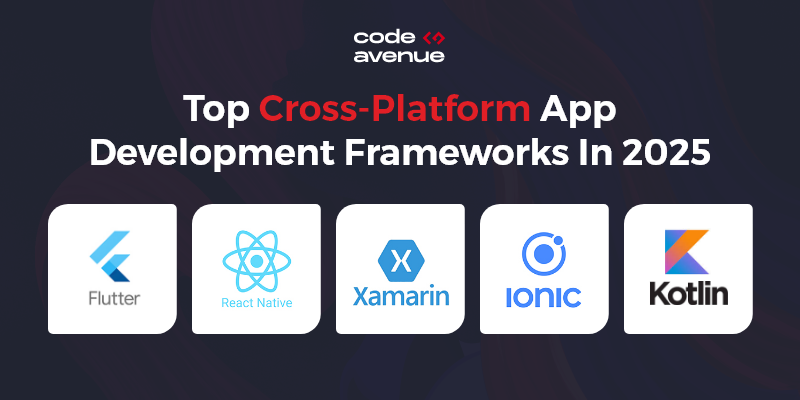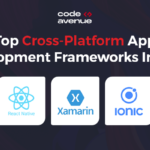Businesses operating in today’s transforming digital world need mobile applications that run flawlessly on different platforms yet maintain peak operational standards alongside optimal user enjoyment. A majority of developers (over 70%) now use cross-platform development methods to lower expenses and shorten application development cycles.
Data shows that the global cross-platform app development market will reach $162.25 billion by 2028 reflecting its growing market demand. Modern framework developments enable businesses to develop responsive apps matching native development quality.
According to a survey in 2023, Flutter was selected by around 46% of developers as the most used cross-platform framework. However, the most powerful leading cross-platform mobile app development frameworks that are expected to drive the market in 2025 comprise Flutter, React Native, Xamarin, Ionic, and Kotlin Multiplatform.
What Is A Cross-Platform App Development Framework?
The infrastructure of a framework of any cross-platform app development company allows programmers to develop applications once through a single codebase that operates across multiple operating systems such as iOS and Android.
Cross-platform frameworks serve as alternatives to native development because they combine a single codebase into one framework that operates across diverse platforms while minimizing costs through streamlined development.
Key Benefits Of Cross-Platform App Development Frameworks:
- Cost Efficiency- Eliminates requirements for separate development teams.
- Faster Development- A single codebase enables accelerated development time.
- Wider Reach- Deploy apps on multiple platforms simultaneously.
- Consistent UI/UX- Ensures uniformity across devices.
- Code Reusability- Apps can reuse code to eliminate repetitive tasks.
What Are The Best Cross-Platform Mobile App Development Frameworks In 2025
- Flutter
Developed by: Google
Best For: High-performance apps with a native feel
Programming Language: Dart
The prominence of Flutter in cross-platform app development services remains unchallenged during 2025 because of its quick rendering engine together with Hot Reload features and its ample widget library. Companies including Alibaba and BMW depend on Flutter technology because it delivers fluid performance and native-like interaction.
| Pros | Cons |
| High-performance UI rendering | Size exceeds standard native framework apps |
| Extensive widget customization | Limited support for complex animations |
| Strong community and Google support |
- React Native
Developed by: Meta (Facebook)
Best For: Apps with reusable UI components
Programming Language: JavaScript
In 2025 React Native stands out as an exceptional choice for any cross-platform mobile app development company because it integrates component-based design with its broad ecosystem support alongside its reusable code structure. The mobile applications of Uber Eats, Instagram, and Airbnb use React Native to create visualization-rich applications.
| Pros | Cons |
| Large developer community and third-party library support | Performance lag in complex applications |
| Works on both web apps and mobile platforms | Limited access to native APIs |
| Fast development with Hot Reload |
- Xamarin
Developed by: Microsoft
Best For: Enterprise applications
Programming Language: C#
The enterprise-grade cross-platform mobile app development services prefer Xamarin as the main platform that operates within Microsoft’s .NET ecosystem as a product. The framework operates at native levels and if you hire cross-platform app developers, you can see how they use its code base repeatedly across different platforms through a reusability of 90%.
| Pros | Cons |
| Direct access to native APIs | Heavier applications due to dependencies |
| Strong integration with Visual Studio | Smaller community base than Flutter and React Native |
| Excellent support for enterprise apps |
- Ionic
Developed by: Drifty Co.
Best For: Progressive Web Apps (PWAs)
Programming Language: JavaScript, HTML, CSS
Organizations seeking quick development of lightweight PWAs can choose Ionic due to its effective framework capabilities. Unlike other frameworks, Ionic uses web technologies yet provides a Capacitor to enable native functionality within its system. They also deliver the best cross-platform messaging apps with their capabilities and UI components.
| Pros | Cons |
| Open-source and easy-to-learn | Less efficient for complex apps |
| Strong UI component library | WebView results in performance reduction |
| Works well with Angular, React, and Vue.js |
- Kotlin Multiplatform
Developed by: JetBrains
Best For: Apps requiring high code-sharing capabilities
Programming Language: Kotlin
Kotlin Multiplatform emerges as one of 2025’s standout frameworks for developers searching “how to create a cross-platform app” because it enables businesses to use shared code between Android and iOS platforms with native features enabled. The platform stands out as a preference for developers because it offers Java integration together with straightforward integration capabilities.
| Pros | Cons |
| High code reusability | Struggles with third-party libraries |
| Native performance optimization | Experience needed to work efficiently |
| Seamless integration with existing Android apps |
How To Choose The Right Cross-Platform Framework For Your Project
Selecting the best framework depends on your project requirements, budget, performance expectations, and developer expertise. Here’s a quick comparison:
| Feature | Flutter | React Native | Xamarin | Ionic | Kotlin Multiplatform |
| Performance | ⭐⭐⭐⭐⭐ | ⭐⭐⭐⭐ | ⭐⭐⭐⭐ | ⭐⭐⭐ | ⭐⭐⭐⭐⭐ |
| Ease Of Use | ⭐⭐⭐ | ⭐⭐⭐⭐⭐ | ⭐⭐⭐ | ⭐⭐⭐⭐ | ⭐⭐⭐⭐ |
| Community Support | ⭐⭐⭐⭐⭐ | ⭐⭐⭐⭐⭐ | ⭐⭐⭐⭐ | ⭐⭐⭐ | ⭐⭐⭐ |
| Best For | UI-rich apps | Reusable UI | Enterprise | PWA | Code-sharing |
What Are The Key Features To Look For In A Cross-Platform Framework
- High Code Reusability
Quality cross-platform frameworks permit developers to write code once while achieving global deployment across all platforms without sacrificing speed or performance.
Key Considerations:
- Single Codebase Technology Shortens development schedules and decreases project expenses.
- The near native-like speed ensures smooth animations and fast load times during traffic.
- Frameworks that compile directly into native code produce better execution efficiency.
Notable Frameworks: Flutter, Kotlin Multiplatform, React Native
- UI and Customization
Look for a user interface that demonstrates careful design qualities, and enables better platform engagement and user-friendly interaction which is one of the advantages of cross-platform apps.
Key Considerations:
- Pre-built UI elements of cross-platform offer a foundation for faster development.
- The design framework enables easy adjustment to follow each platform’s specific guidelines.
- This ensures smooth interactions through animations for an improved user experience.
Notable Frameworks: Flutter, Jetpack Compose, SwiftUI for cross-platform UI consistency
- Third-Party Integration & APIs
Complete access to native features remains essential for all applications that need hardware-level functionality to execute their intended functionality.
Key Considerations:
- Smooth interactions with sensor elements along with GPS systems and built-in camera features.
- Third-party libraries and plugins expand functionality through different features.
- Developers can build platform-specific enhancements through Custom Native Code Integration.
Notable Frameworks: Three major frameworks include React Native (Bridging for native modules), Xamarin, and Kotlin Multiplatform.
- Fast Development Cycle
Apps that streamline development processes or possess a simple design like a cross-platform notes app deliver faster market deployment alongside improved debugging capabilities.
Key Considerations:
- Hot Reload functions as a tool that lets users edit applications while they remain active.
- Offer instant feedback on UI changes through a real-time preview of coding.
- The framework accelerates development stages as well as testing processes.
Notable Frameworks: Flutter, React Native, SwiftUI
- Long-Term Support & Security
Applications dealing with user data and payments need strong security alongside authentication functions because security remains fundamental.
Key Considerations:
- Built-in security mechanisms enable secure data storage alongside encryption and authentication protection.
- Updates that ensure compatibility with the latest OS versions and security patches.
- Ensure compliance and support with industry standards like GDPR and HIPAA.
Notable Frameworks: Flutter (strong security features), Xamarin, React Native with third-party encryption solutions
Conclusion
Cross-platform development will drive forward the mobile application creation process to deliver enhanced market reach against decreased financial expenses. The various mobile app frameworks including Flutter, React Native, Xamarin, Ionic, and Kotlin Multiplatform offer specialized functionality to accommodate diverse project requirements.
Code Avenue offers custom-built cross-platform applications with performance-specific designs suited for business needs. We create exceptional mobile solutions that meet all requirements from enterprise-grade applications to intuitive user experiences.
Looking to develop a cross-platform app? Contact Code Avenue today!
FAQs
Which cross-platform app framework is best for 2025?
Your selection of the best framework stems from your project necessity. Flutter leads with UI-rich applications and React Native brings reusable components yet Xamarin provides enterprise-grade solutions alongside Ionic’s PWAs and Kotlin Multiplatform delivers code-sharing abilities.
Is cross-platform app development better than native development?
The use of one codebase across multiple platforms allows developers to improve time-to-deployment while lowering total project costs. The performance benefits of native applications shine brightest for apps that need advanced animations along with hardware integrations.
What are the major drawbacks of cross-platform development?
Some drawbacks include:
- Highly complex apps show reduced performance when using cross-platform development.
- The limited exposure to native APIs forces applications to depend on supplementary plugins.
- Native apps tend to be smaller in size than cross-platform alternatives
How do I choose the right framework for my project?
Development choices must consider performance requirements together with financial constraints alongside development difficulty and requirements for native API functions and programmer proficiency. Consult experts at Code Avenue for personalized recommendations when unsure.












They were willing to walk me through their ideas and provide suggestions when I wasn't sure about something.
Marcus Gitau Founder, Kumea, Agriculture Industry